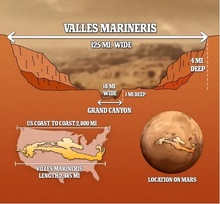
We are proud to announce that Protiti Roy, a third-year PhD student of the Planetary Exploration Group led by Dr. Valerie Payré in the School of Earth, Environment, and Sustainability, has received the NASA Future Investigators in NASA Earth and Space Science and Technology (FINESST) grant. FINESST grants fund well-defined research projects that align with the NASA Science Mission Directorate’s goals for science, technology, and exploration. With a 10% acceptance rate for planetary science, this two-year grant marks a significant achievement for Protiti, SEES, and the University of Iowa.
Protiti’s research grant focuses on morphological and mineralogical characterization of the floor of Mars’ Valles Marineris, the largest canyon in the solar system. Valles Marineris is a 2,500 miles long and 23,000 feet deep canyon that exhibits a unique vertical profile of the martian crust from today to > 4.0 billion years ago. Using remote sensing data, her work aims to characterize fundamental petrological properties of the Valles Marineris floor that presents unexpected high thermal inertias. This project will add to the understanding of the canyon’s formation and relationship to its broader geological evolution, therefore developing constraints around Valles Marineris’ development and evolutionary history. Through its analytical framework, this dissertation will guide future investigations of any high thermal inertia regions observed on Mars beyond Valles Marineris, and is one of the baselines for a helicopter mission concept aiming to land in the canyon.

Figure 1. Comparison of Valles Marineris, Mars, with the Grand Canyon, USA. © Credits: Kevin OReilly